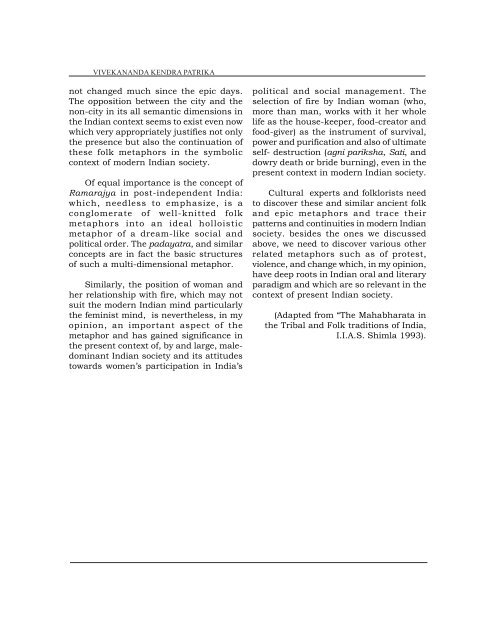Epics in Imprints-1.pdf - Vivekananda Kendra Prakashan
Epics in Imprints-1.pdf - Vivekananda Kendra Prakashan
Epics in Imprints-1.pdf - Vivekananda Kendra Prakashan
You also want an ePaper? Increase the reach of your titles
YUMPU automatically turns print PDFs into web optimized ePapers that Google loves.
VIVEKANANDA KENDRA PATRIKA<br />
not changed much s<strong>in</strong>ce the epic days.<br />
The opposition between the city and the<br />
non-city <strong>in</strong> its all semantic dimensions <strong>in</strong><br />
the Indian context seems to exist even now<br />
which very appropriately justifies not only<br />
the presence but also the cont<strong>in</strong>uation of<br />
these folk metaphors <strong>in</strong> the symbolic<br />
context of modern Indian society.<br />
Of equal importance is the concept of<br />
Ramarajya <strong>in</strong> post-<strong>in</strong>dependent India:<br />
which, needless to emphasize, is a<br />
conglomerate of well-knitted folk<br />
metaphors <strong>in</strong>to an ideal holloistic<br />
metaphor of a dream-like social and<br />
political order. The padayatra, and similar<br />
concepts are <strong>in</strong> fact the basic structures<br />
of such a multi-dimensional metaphor.<br />
Similarly, the position of woman and<br />
her relationship with fire, which may not<br />
suit the modern Indian m<strong>in</strong>d particularly<br />
the fem<strong>in</strong>ist m<strong>in</strong>d, is nevertheless, <strong>in</strong> my<br />
op<strong>in</strong>ion, an important aspect of the<br />
metaphor and has ga<strong>in</strong>ed significance <strong>in</strong><br />
the present context of, by and large, maledom<strong>in</strong>ant<br />
Indian society and its attitudes<br />
towards women’s participation <strong>in</strong> India’s<br />
political and social management. The<br />
selection of fire by Indian woman (who,<br />
more than man, works with it her whole<br />
life as the house-keeper, food-creator and<br />
food-giver) as the <strong>in</strong>strument of survival,<br />
power and purification and also of ultimate<br />
self- destruction (agni pariksha, Sati, and<br />
dowry death or bride burn<strong>in</strong>g), even <strong>in</strong> the<br />
present context <strong>in</strong> modern Indian society.<br />
Cultural experts and folklorists need<br />
to discover these and similar ancient folk<br />
and epic metaphors and trace their<br />
patterns and cont<strong>in</strong>uities <strong>in</strong> modern Indian<br />
society. besides the ones we discussed<br />
above, we need to discover various other<br />
related metaphors such as of protest,<br />
violence, and change which, <strong>in</strong> my op<strong>in</strong>ion,<br />
have deep roots <strong>in</strong> Indian oral and literary<br />
paradigm and which are so relevant <strong>in</strong> the<br />
context of present Indian society.<br />
(Adapted from “The Mahabharata <strong>in</strong><br />
the Tribal and Folk traditions of India,<br />
I.I.A.S. Shimla 1993).

















